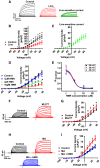KV7.1 channel blockade inhibits neonatal renal autoregulation triggered by a step decrease in arterial pressure
- PMID: 35001664
- PMCID: PMC8816635
- DOI: 10.1152/ajprenal.00568.2020
KV7.1 channel blockade inhibits neonatal renal autoregulation triggered by a step decrease in arterial pressure
Abstract
KV7 channels, the voltage-gated K+ channels encoded by KCNQ genes, mediate heterogeneous vascular responses in rodents. Postnatal changes in the functional expression of KV7 channels have been reported in rodent saphenous arteries, but their physiological function in the neonatal renal vascular bed is unclear. Here, we report that, unlike adult pigs, only KCNQ1 (KV7.1) out of the five members of KCNQ genes was detected in neonatal pig renal microvessels. KCNQ1 is present in fetal pig kidneys as early as day 50 of gestation, and the level of expression remains the same up to postnatal day 21. Activation of renal vascular smooth muscle cell (SMC) KV7.1 stimulated whole cell currents, inhibited by HMR1556 (HMR), a selective KV7.1 blocker. HMR did not change the steady-state diameter of isolated renal microvessels. Similarly, intrarenal artery infusion of HMR did not alter mean arterial pressure, renal blood flow, and renal vascular resistance in the pigs. An ∼20 mmHg reduction in mean arterial pressure evoked effective autoregulation of renal blood flow, which HMR inhibited. We conclude that 1) the expression of KCNQ isoforms in porcine renal microvessels is dependent on kidney maturation, 2) KV7.1 is functionally expressed in neonatal pig renal vascular SMCs, 3) a decrease in arterial pressure up to 20 mmHg induces renal autoregulation in neonatal pigs, and 4) SMC KV7.1 does not control basal renal vascular tone but contributes to neonatal renal autoregulation triggered by a step decrease in arterial pressure.NEW & NOTEWORTHY KV7.1 is present in fetal pig kidneys as early as day 50 of gestation, and the level of expression remains the same up to postnatal day 21. KV7.1 is functionally expressed in neonatal pig renal vascular smooth muscle cells (SMCs). A decrease in arterial pressure up to 20 mmHg induces renal autoregulation in neonatal pigs. Although SMC KV7.1 does not control basal renal vascular resistance, its inhibition blunts neonatal renal autoregulation engendered by a step decrease in arterial pressure.
Keywords: KCNQ; KV7.1; neonates; renal autoregulation; smooth muscle cells.
Conflict of interest statement
No conflicts of interest, financial or otherwise, are declared by the authors.
Figures






Similar articles
-
Contribution of Kv7 channels to natriuretic peptide mediated vasodilation in normal and hypertensive rats.Hypertension. 2015 Mar;65(3):676-82. doi: 10.1161/HYPERTENSIONAHA.114.04373. Epub 2014 Dec 29. Hypertension. 2015. PMID: 25547342
-
TRPV4 channels contribute to renal myogenic autoregulation in neonatal pigs.Am J Physiol Renal Physiol. 2017 Nov 1;313(5):F1136-F1148. doi: 10.1152/ajprenal.00300.2017. Epub 2017 Aug 2. Am J Physiol Renal Physiol. 2017. PMID: 28768667 Free PMC article.
-
Functional assembly of Kv7.1/Kv7.5 channels with emerging properties on vascular muscle physiology.Arterioscler Thromb Vasc Biol. 2014 Jul;34(7):1522-30. doi: 10.1161/ATVBAHA.114.303801. Epub 2014 May 22. Arterioscler Thromb Vasc Biol. 2014. PMID: 24855057
-
Novel treatment strategies for smooth muscle disorders: Targeting Kv7 potassium channels.Pharmacol Ther. 2016 Sep;165:14-25. doi: 10.1016/j.pharmthera.2016.05.002. Epub 2016 May 11. Pharmacol Ther. 2016. PMID: 27179745 Review.
-
Cardiovascular KCNQ (Kv7) potassium channels: physiological regulators and new targets for therapeutic intervention.Mol Pharmacol. 2008 Nov;74(5):1171-9. doi: 10.1124/mol.108.049825. Epub 2008 Aug 6. Mol Pharmacol. 2008. PMID: 18684841 Review.
Cited by
-
Behavior of KCNQ Channels in Neural Plasticity and Motor Disorders.Membranes (Basel). 2022 May 6;12(5):499. doi: 10.3390/membranes12050499. Membranes (Basel). 2022. PMID: 35629827 Free PMC article. Review.
-
The renal vasodilatation from β-adrenergic activation in vivo in rats is not driven by KV7 and BKCa channels.Exp Physiol. 2024 May;109(5):791-803. doi: 10.1113/EP091618. Epub 2024 Mar 9. Exp Physiol. 2024. PMID: 38460127 Free PMC article.
-
Potassium channel-mediated NO-induced vasodilation during maturation: Dominance of Kv7 channels.FASEB Bioadv. 2025 Jan 24;7(3):e1490. doi: 10.1096/fba.2024-00178. eCollection 2025 Mar. FASEB Bioadv. 2025. PMID: 40060946 Free PMC article.
-
Activation of renal vascular smooth muscle TRPV4 channels by 5-hydroxytryptamine impairs kidney function in neonatal pigs.Microvasc Res. 2023 Jul;148:104516. doi: 10.1016/j.mvr.2023.104516. Epub 2023 Mar 6. Microvasc Res. 2023. PMID: 36889668 Free PMC article.
References
-
- Chadha PS, Zunke F, Zhu HL, Davis AJ, Jepps TA, Olesen SP, Cole WC, Moffatt JD, Greenwood IA. Reduced KCNQ4-encoded voltage-dependent potassium channel activity underlies impaired β-adrenoceptor-mediated relaxation of renal arteries in hypertension. Hypertension 59: 877–884, 2012. doi:10.1161/HYPERTENSIONAHA.111.187427. - DOI - PubMed
Publication types
MeSH terms
Substances
Grants and funding
LinkOut - more resources
Full Text Sources

